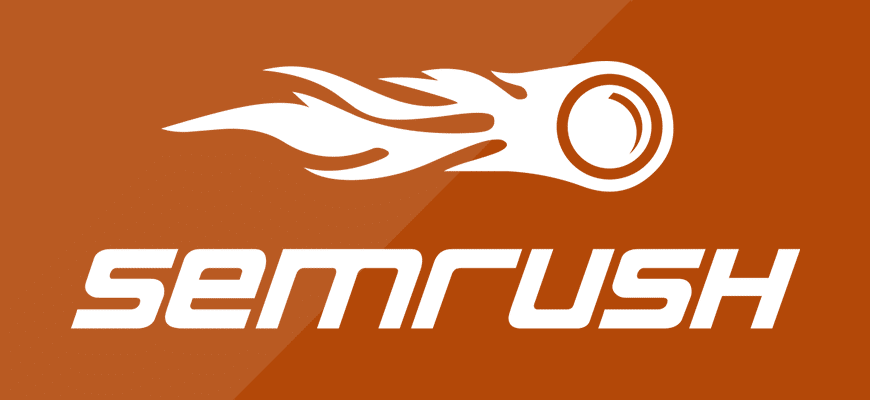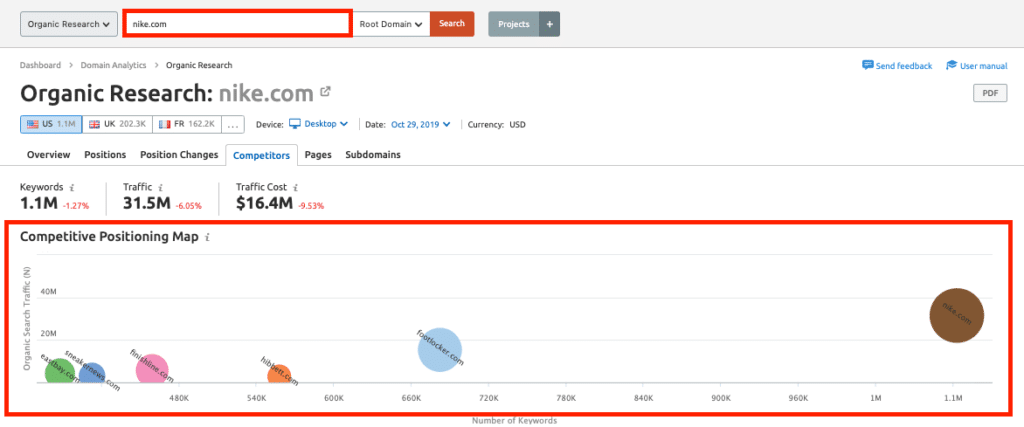Ever wonder why your competitors are outranking you or how they’re getting so much traffic from their Google ads?
Want to outperform your competitors? Then keep reading.
It’s very important to learn a lot about your competitors, their marketing strategy, and their website analytics, so you can make the right adjustments and improve your own site.
In this post, I’ll be talking about:
1. What exactly is a competitor site analysis
2. Why a competitor site analysis is important
3. What to focus when you perform a site analysis
4. Seeing the Google ads of your competitors
5. The best SEO tool for seeing the website analytics of your competitors.
A good competitor site analysis will help you RANK higher, get more TRAFFIC, and earn CONVERSIONS.
What is A Competitor Site Analysis?
A competitor site analysis is essentially an assessment of the strengths and weaknesses of your competitors website.
This competitive analyis provides the individual to identify opportunities and threats to their own website and allow for strategies that improve their site.
An important aspect of a website analysis is keyword competition analysis.
Keyword competition analysis is the process of evaluating how the top rankings keywords of your competitors perform.
Why is A Competitor Site Analysis Important?
A competitor site analysis is very important if you want to boost your business and outperform your competition.
To beat the competition, you should observe your competitors’ every marketing move, keywords, search rankings, social media and other ways they’re growing their business.
Doing a proper site analysis on your competitor will give you insight into what you need to do better so you can get that competitive edge.
Heres 3 key things you can gain from doing a good competitor site analysis:
1. Get Inspired and Find New Ways to Reach Your Customers or Audience
Doing a competitor site analysis, you can learn new strategies from your competitors that can help connect you to your customers or audience.
After you do that, you can focus on retention, which is keeping your audience or customer engaged and satisfied.
2. Know Your Competitor’s Search and Market Optimization Strategy and Find A Way To Do it Better
Once you know what your competitors are doing, you can find a way to do it better.
One of the best ways to do this is to create a value proposition that they don’t address. Giving value is what makes people want to visit your site, drive sales, make them loyal to your brand or services.
When you know what your competitor is doing, you are able to identify gaps.
3. Beat Your Competition Based on Data Instead of Assumptions
Instead of making decisions based on flawed assumptions, you can use reliable SEO tools to do a competitor site analysis and make strategic decisions.
Things to Focus On in a Competitor Site Analysis
There are various SEO tools you can use to perform a competitor site analysis and they might give you alot of data and information.
However, there are three things you want to focus on when performing a competitor site analysis:
- Top keywords
- Number of backlinks and where they come from
- Top pages
1. Keywords
Researching and targetting the right keywords is essential to growing your site.
However, you are constantly competing with other sites for keywords and it can be extremely difficult to get traffic.
There are few important things to consider when your researching keywords.
Keywords should be valuable (i.e. high volume, related to your website or business, or likely to convert)
Furthermore, they should also be keywords that you can rank for. In other words, they must be low competition.
When your doing a site analysis, its important to have the right SEO tool, preferrably one that compares two or more competitors and gives you a rich analysis regarding their keywords.
Another good idea is to try to rank for keywords that your competition is ranking for.
Many SEO tools also have a feature called keyword difficulty, which allows you to target keywords that are not too competitive. This means this particular keyword is easier to rank for.
It’s also good to find low competition keywords with high search volume that your competitor is not targeting.
2. Backlinks
When a webpage links to any other page, it’s called a backlink.
Backlinks are important for ranking. A page with a lot of backlinks typically ranks higher better on Google.
So even if you have better quality content than some of your competitors when you are first starting your site, they still may rank higher than you because they have built more backlinks over a longer period of time.
Good backlinks are difficult to obtain.
However, we can use SEO tools and data to find good links that are somewhat easier to obtain. But where?
The answer is sites that have already linked to your competitors, but haven’t linked to you.
This is why a competitor site analysis is so important.
If you can show those sites that your resource is significantly better than your competitors, you have a better-than-average chance of earning a link as well.
Another benefit is that this process helps you to find other relevant pages to get links from.
3. Top Pages
Another thing to look at during a competitor site analysis is the top performing content of your competitor.
Three important things to do:
- Discover your competitor’s top content
- Create your own content that significantly improves upon it in one or more ways
- Promote your content to a similar group of people
The key is to not simply recreate your competitor’s content but to significantly improve upon it.
You could add additional information, more data, charts, tables, stunning visuals, or anything that makes the content more appealing or useful.
There are alot of SEO tools that allow you to find your competitor’s top pages by traffic.
Once you have access to accurate traffic estimates for each page, you can use this data to find good topics and keywords.
See Competitors Google Ads
Targeting relevant, high-intent keywords, structuring campaigns into logical, relevant ad groups, and getting rid of negative keywords are all steps you should take to build strong Pay Per Click (PPC) campaigns.
However, there are times when you need to research your competitors’ Google Ads and see what their PPC campaigns look like.
How much are they spending? What keywords are they advertising on? And how profitable are they?
Some of these questions can be answered. Your competitor can’t hide certain things even if they want it hidden.
There are a ton of keyword/PPC tools that specialize in giving this competitive research information.
If you use a good PPC tool you’ll be able to find out:
- The keywords your competitors are using.
- Which of their keywords are performing the best.
- How long their ads ran or have run for certain keywords.
- The clicks and impressions they received from their ads.
- The best performing ads.
- Your competitors’ ad copy.
- Your competitors’ monthly ad spend on campaigns.
Let’s say that you’re investing the same amount of money into AdWords PPC as your competitors, but you discover that they’re making more money. It’s possible that your keywords aren’t profitable in the competitive landscape.
You can use a SEO tool that shows you exactly what paid keywords that competitors are targeting.
Then, you can find profitable keywords that your competitors are using to enhance your own market share.
Why it’s Important to See Competitor’s Google Ads
It’s important to see your competitors Google Ads because they can help improve your own campaigns.
Once you use see your competitor’s google ads, you can get the answer to three important questions:
- Which competitors are on Google Ads?
- Have they recently increased or decreased spending?
- Are there any seasonal trends in their advertising?
Important Metrics in Google Ads
There are many factors that impact the performance of your Google Ads. Here are the most important metrics:
- Conversion Rate (How often people click your ads)
- Ad Relevance (Does the ad content match your keywords?)
- Landing Page Experience (Are people leaving as soon as you they land on your site?)
Best SEO Tool For Competitor Analysis and Seeing Your Competitors’ Google Ads

The best SEO tool for doing a competitor analysis and seeing your competitor’s Google ads is SEMrush.
The reason why SEMrush is the best SEO tool for a competitive site analysis is because it specializes in competitor data.
SEMrush instantly gives you a list of your competitors when you type in a domain and can give you a side by side comparison of your competitors.
You can use SEMrush to conduct competitive research on any site and then use the data to optimize your campaigns.
SEMrush is a versatile tool that has a TON of useful features that make it great for a competitor analysis. This includes:
- Keyword Research
- Competitor Research
- Site Audit
- Backlink Analysis
The best part is that the data you get is user friendly and can come in a graphic format.

The hardest part about conducting a competitive analysis is turning data into action that you can use to develop or improve your content strategy.
SEMrush offers features that recommend some of the best actions to take after you do an analysis of your site and your competitor.
Spying on your competitors and collecting vital data for optimizing your content is key to improving your site.
SEMrush Finds Your True SEO Competitors Easily
Before you can do any SEO competitive analysis, you need to know who your competitors actually are. You may think you know, but until you dive into the data, it’s not always obvious.
The “novice” way of identifying your competitors is to simply enter your top keyword in Google, then see which domains are ranking.
For increased accuracy, you could do this for 10–20 of your most popular keywords, track everything in a spreadsheet, and calculate which domains appear the most frequently and in what position.
The problem with this approach is that you often rank for hundreds or thousands of keywords at a time, and checking can be tedious and inaccurate.
SEMrush fixes this for you.
Simply enter your domain and the tool shows you the true competitors that compete for the same keywords as your domain, ranked by visibility.
Seeing Your Competitor’s Google Ads With SEMrush

Spying on your competitor’s Google ads can give you some ideas for what you can do and understand what’s best NOT to do.
Save yourself tons of time and money.
SEMrush has a report which gives a pretty solid overview of paid keywords, the estimated cost of those keywords in Google AdWords traffic volume, and percentage of all traffic.
SEMrush accurately identifies the best performing keywords.
SEMrush Pricing
There are three plans:
The Pro Plan is about $99 per month
The Guru Plan is about $199 per month
The Business Plan is about $399 per month
You can get a free trial for any of the plans.
Conclusion
Click HERE for a FREE TRIAL of SEMrush so you can start performing a site analysis of your competitors and start seeing your competitor’s Google Ads.
After you sign up for a free trial, click HERE for EASY step by step instructions on the best way to perform a competitor site analysis with SEMrush, how to see your competitor’s Google Ads, and learn how to ANALYZE and OUTPERFORM your competitor.
*Disclosure: The links on this page may give us a commission in order to run the website.
For more post like this, check out:
Best SEO Software For White Label Reports
Don’t forget to subscribe to get more tips on using SEMrush and other services that can help grow your website!
[convertkit form=1548253]

Be First to Comment